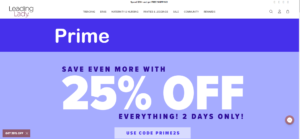The results from Amazon.com Inc.’s “Prime Early Access Sale” show that shoppers avoided spending money on large-ticket items as worries about inflation grow. That’s mixed news for merchants who hoped the two-day sale would herald the start of a holiday shopping boom.
While third-parties and researchers are still working on estimates, early results suggest retailers that sold televisions, desktop computers and other more expensive items fared poorly during the Early Access event, according to Chicago-based market research firm Numerator’s survey of 1,025 verified Early Access shoppers. But merchants that sell lower-cost items on Amazon’s marketplace did well during the Early Access event. Some 58% of items purchased during the early hours of the Amazon sale cost less than $20, according to Chicago-based market research firm Numerator, indicating shoppers weren’t spending heavily.
Amazon said Prime members ordered more than 100 million items from merchants during the Early Access sale. Some of the best-selling items in the United States included Laneige Lip Sleeping Mask, Apple AirPods (2nd Generation), Vital Proteins Collagen Peptides, and Crest 3D Whitestrips Professional Effects Teeth Whitening Strips. Amazon did not released dollar figures.
Tom Funk, director of ecommerce for Ann Clark Cookie Cutters, said sales on Amazon for his company were about 15% higher than on an average day.
“For many sellers, this season is primarily a buildup to holiday,” Funk told Digital Commerce 360. “But for us on Amazon, Halloween is a busy season in its own right, with cookie cutters and baking supplies seeing healthy seasonal demand. We are not discounting or offering any Early Access promotions. I imagine many sellers are feeling inflationary pressures, so I’d expect discounting to be muted.”
Promotions and discounts during Amazon Prime Early Access
Hanna Houglum, vice president of Art of Tea, said sales rose 35% during the event compared to an average day. However, rising advertising costs as well as shoppers increasing their use of Amazon-specific coupons across Art of Tea’s product pages put pressure on margins.
“We noticed our coupon utilization rate grow by about 20% throughout the event, signaling that consumers were heavily influenced by special discounts for our products,” Houglum told Digital Commerce 360. “However, our keywords saw a drastic decrease in efficiency throughout the event as key branded terms became much more expensive to bid against.”
The final result was that “our sales ended up at about 15% to 20% over what a typical Tuesday and Wednesday would have looked like,” Houglum said.
Houglum also said sales during the July Prime Day event were about 25% higher than during Early Access and that return-on-advertising-spend was about 20% better during the July event.
Leading Lady Co., which sells bras, offered discounts on its Amazon store and held a sitewide sale on its direct-to-consumer website during the Early Access event.
“There has been a lot of hype in the media about people shopping earlier again this year,” Barbara Shears, ecommerce and marketing director at Leading Lady, told Digital Commerce 360. “So we have boosted our ad spend to try to get in front of some of the early traffic.”
The tactics worked. The retailer’s Amazon store sales increased 30% compared with the prior two days. Meanwhile, the DTC website sales increased more than 40%.
Beyond Amazon
Eighty retailers in the Top 100 held some sort of promotion on their own sites during the Early Access event. Of those, 8.8% of retailers competed directly with Amazon, running a Prime Day Early Access-like sale, according to a website check of a panel of 100 retailers by Digital Commerce 360. That’s down from the 38.0% of 79 retailers that ran a sales event during Amazon’s Prime Day event in July.

Leading Lady referred directly to the Amazon sale on its own website.
Fewer retailers offered percent-off discounts (71.3%) as part of the October promotion.
Some retailers managed to successfully pre-empt the Early Access sale, according to estimates from Salesforce Inc.
- U.S. non-Amazon sales during the Prime Day event were essentially flat year over year when compared with the Tuesday and Wednesday of the comparable week in 2021. Sales grew only 2%. But over the weekend (Thursday through Sunday), online sales grew 10% versus the comparable weekend last year.
- Compared with the same period in 2020, sales were up even higher at 19%. With brands and. retailers like Target starting their sales events early, the industry had success pulling sales ahead of the weekday Prime event.
And outside of Amazon, retailers embraced price cutting, Salesforce said. The average discount was just over 21% during the Tuesday and Wednesday Prime event on non-Amazon sites. That’s a 25% increase in year-over-year discount rates. Outside of the Cyber Five period of Thanksgiving through Cyber Monday, that’s the deepest discount rate seen since the start of the pandemic, according to Salesforce.
Inflation worries
Concerns about inflation among both merchants and shoppers during the sale proved warranted. On Oct. 14 — the day after the sale ended — the U.S. Bureau of Labor Statistics announced inflation rose 8.2% in September from a year earlier. Food costs have risen 11.2% in the past year, prompting households to cut back on discretionary spending.
Kristin McGrath, a shopping expert at the deal-tracking website BlackFriday.com, told Bloomberg News that inflationary pressure caused shoppers to shun major purchases.
“A lot of the TV deals (during the sale) were surprisingly good,” she said. “But are these the things people are looking to buy if they’re worried about paying for their next grocery run?”
Amazon is ranked No. 1 in the Digital Commerce 360 Top 1000.
Gretchen Salois and Bloomberg News contributed to this article.
Sign up
Stay on top of the latest developments in the ecommerce industry. Sign up for a complimentary subscription to Digital Commerce 360 Retail News.
Follow us on LinkedIn, Twitter and Facebook. Be the first to know when Digital Commerce 360 publishes news content.
Favorite